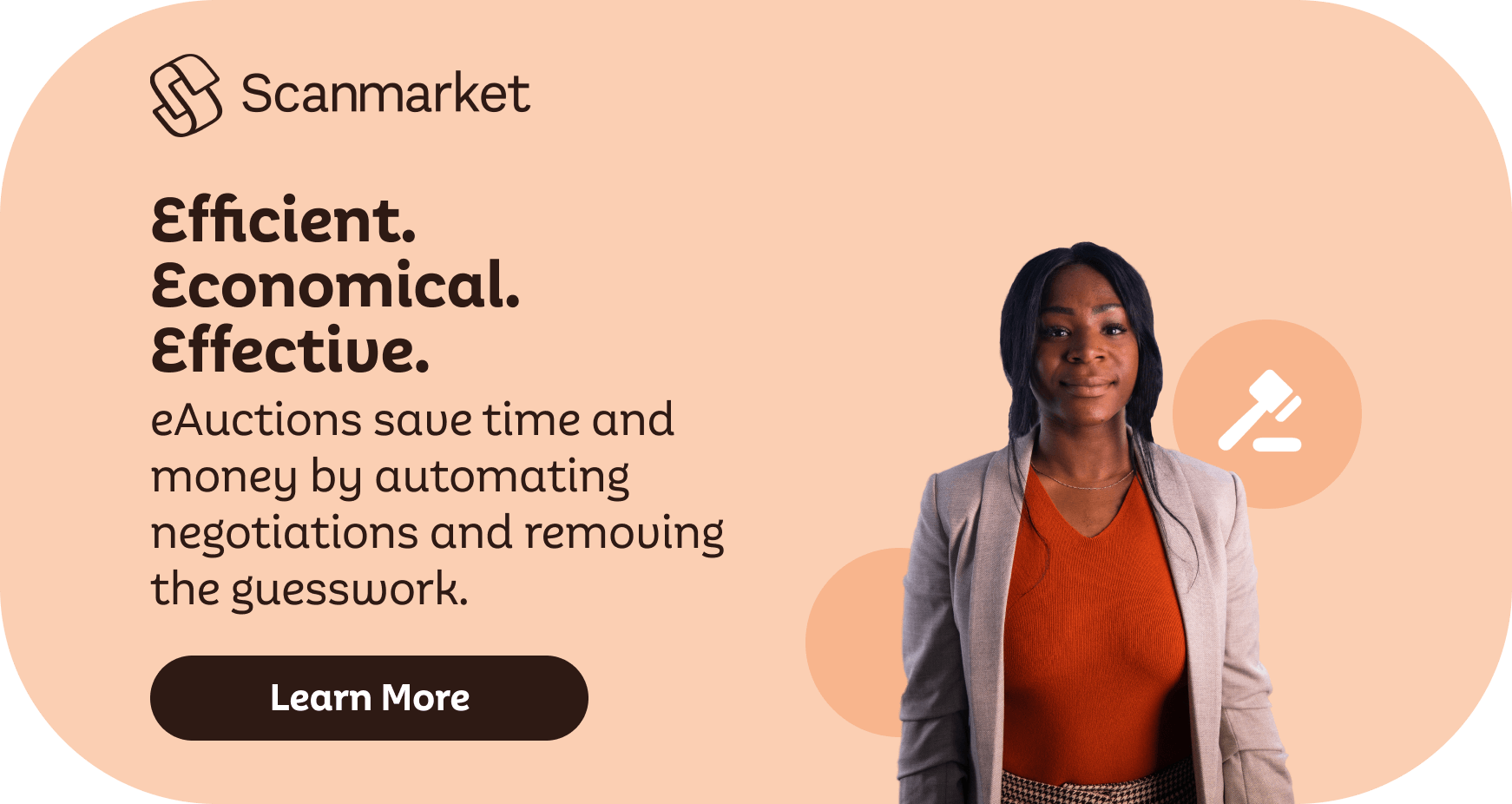Last August I was invited by Michael Cadieux, CEO of Procurement Foundry, as a guest speaker on their Webinar titled: “Harnessing the Power of Procurement: How Integrating Automated Negotiations with eAuctions Can Drive Operational Optimization”, which you can watch in full right here.
During the event I had the delightful opportunity to impart my personal perspectives and insights regarding the state of eAuctions in 2023. I’d like to share the key takeaways from this experience with you on this blog post.
Reverse eAuctions are Powerful
As I highlighted during the event, eAuctions first emerged in the mid-1990s, primarily within the automotive sector. From there, they proliferated into retail, healthcare, and throughout the supply chain, transcending industry boundaries and evolving into a genuine phenomenon.
Since Scanmarket was founded in 1999, various auctions formats have emerged, encompassing Reverse Auctions with options like Cherry Picking, List and CherryLot, as well as Step Auctions featuring CherryDutch and Japanese auction variations.
I've placed particular emphasis on reverse auctions because in these auctions, suppliers compete to provide the lowest bids. The dynamics of these auctions drive down prices, making them a powerful tool for procurement professionals.
eAuction Adoption Around the Globe
Mike posed a question inquiring about the geographical disparities in eAuction adoption. I explained that it's not so much about where auctions are more prevalent but rather the way they are used. For example, in China, auctions are run in high volumes but often with smaller spends, whereas in Europe and the United States, larger spends are the standard practice.
RFPs and eAuctions are Complimentary
Our discussion then circled back to the core question: Is the RFP process going extinct due to eAuctions?
As I noted, RFPs are still a crucial part of supplier qualification and understanding of the completive landscape.
In fact, eAuctions are not solely about price, they should focus on the total cost of ownership. The RFP phase helps identify supplier differences in terms of service levels, quality, and more, which can then be factored into the auction. This strategic approach ensures that the winning supplier not only offers the lowest price but also provides the best overall value.
Fundamentally, I do not perceive the RFP process as facing extinction because of eAuctions. The key lies in striking the appropriate equilibrium and deploying each approach where it proves most advantageous. eAuctions enhance efficiency and transparency in procurement, yet RFPs continue to serve as the initial gateway for supplier qualification and grasping the nuances of the market.
Defining the Purpose of an eAuction is Paramount
As I pointed out to Mike, eAuction strategies may seem complex, but they hold immense potential. There is however a clear need to develop a robust strategy for eAuctions, just like with any other procurement process.
Understanding the auction’s purpose is paramount. It can be about more than just cost savings, it could be about supplier consolidation, price compression, cost avoidance, quality improvement, or achieving other specific goals.
The Optimal Number of Suppliers
Determining the right number of suppliers to involve in an eAuction is crucial. Statistical Analysis reveals that there’s an optimal range, typically up to seven or eight suppliers, where meaningful savings can be achieved. Beyond this point, adding more suppliers often doesn’t result in significant cost reductions.
Strategically selecting a balanced mix of suppliers, including both cost-effective and higher-priced options, can help drive completive bidding and secure the best overall prices. This understanding empowers buyers to evaluate whether expanding their supplier base or refining specifications to accommodate more suppliers will provide substantial value.
Do eAuctions Negatively Impact Supplier Relationships?
A common concern is whether eAuctions negatively impact supplier relationships. The key to preserving these relationships lies in effective communication. Properly preparing suppliers, explaining the auction process, and reassuring them that their offerings are being evaluated based on total cost of ownership can mitigate concerns.
Maintaining an open line of communication with suppliers throughout the auction process is essential. Suppliers should be aware of the competitive landscape and understand their position relative to others, which can foster transparency and trust.
In summary, eAuctions, when executed strategically, can enhance supplier competition, and yield substantial savings. Choosing the right auction type, optimizing the number of suppliers, and maintaining transparent communication are pivotal in harnessing the power of eAuctions without harming supplier relationships. Ultimately, eAuctions should be seen as a tool to improve procurement efficiency, not as a barrier to effective collaboration with suppliers.
The Leading Category in 2022
For those of you that haven’t had a chance to review it, Scanmarket annually publishes the Global eAuction Index (GEI), providing valuable insights into the performance of eAuctions conducted worldwide on our platform.
As I pointed out during the event and based on findings from this report, the year 2022 saw services emerge as the dominant category in eAuctions. This might come as a surprise initially, given that services are often considered less suitable for auctions when compared to tangible goods. Nevertheless, services such as temporary labor, cleaning, and security services claimed the top positions in the rankings.
The dominance of services in e-Auctions can be attributed to their universality. Unlike specific verticals or industries, services are a common necessity for almost every company. Whether it's janitorial services, temporary staffing, or security, these are vital for business operations across the board. Hence, they become prime candidates for eAuctions, as they cater to a broad spectrum of organizations.
The power of eAuctions in the services category becomes evident when we analyze the savings achieved. In a year marked by rising prices, eAuctions demonstrated their value as cost avoidance tools. A remarkable saving of 4.83% showcases the potential for substantial cost mitigation when services are subjected to eAuctions.
While services encompass a wide range of offerings, some lend themselves more naturally to eAuctions than others. Take cleaning services, for example. The specifications for cleaning can often be well-defined, and there is robust competition in the market, making it conducive to eAuctions. Even when a company's incumbent supplier has specified the cleaning scope, e-Auctions can still introduce competitive dynamics.
Context plays a significant role in the success of e-Auctions. The market conditions and the urgency of procurement needs can impact the decision to auction certain services. For instance, in the freight industry, the chaotic and unpredictable market fluctuations of 2022 led to unique opportunities in the spot market. Companies could leverage eAuctions to secure cost-effective transportation solutions when carriers had available capacity.
Additional Take Aways
Here are a few additional take aways that I’ve shared throughout the event:
- The Best Month/Day to Drive Savings – According to statistics, Thursdays in June are statistically the best days to run auctions. It's a nugget of information that can potentially save organizations significant amounts of money. Imagine being able to optimize your procurement activities by simply choosing the right day and month for e-auctions.
- The Worst Day to Run eAuctions – I’ve also highlighted that statistically, Fridays might not be the best day for e-auctions. While it might seem convenient to wrap up the week with negotiations, the data suggests that it might not yield the highest savings.
- Test Auctions are a Must – When it comes to engaging suppliers who are new to the world of eAuctions, the consensus is clear—test auctions are an absolute must. They provide a safe environment for suppliers to familiarize themselves with the platform, the UI, and the dynamics of the auction process. By simulating real bidding scenarios, participants can build confidence and reduce the risk of panic during live auctions.
- Use eAuctions Wisely –Auctions aren't a one-size-fits-all solution. Instead, they should be used judiciously in situations where market competition exists, and product or service specifications are well-defined. Employing eAuctions selectively yields the best results.
In Conclusion
eAuctions are a valuable tool that should be in every procurement professional's arsenal. They're not about replacing traditional methods but about optimizing your purchasing strategy. Use them wisely to drive value and make informed decisions that benefit your organization.













